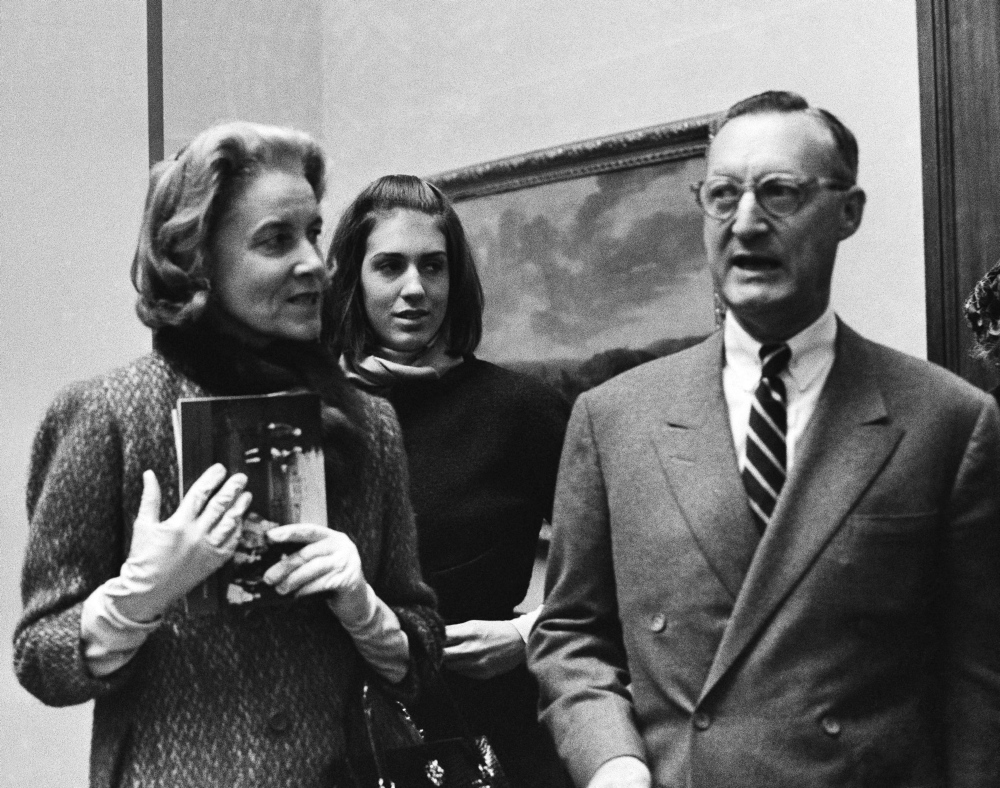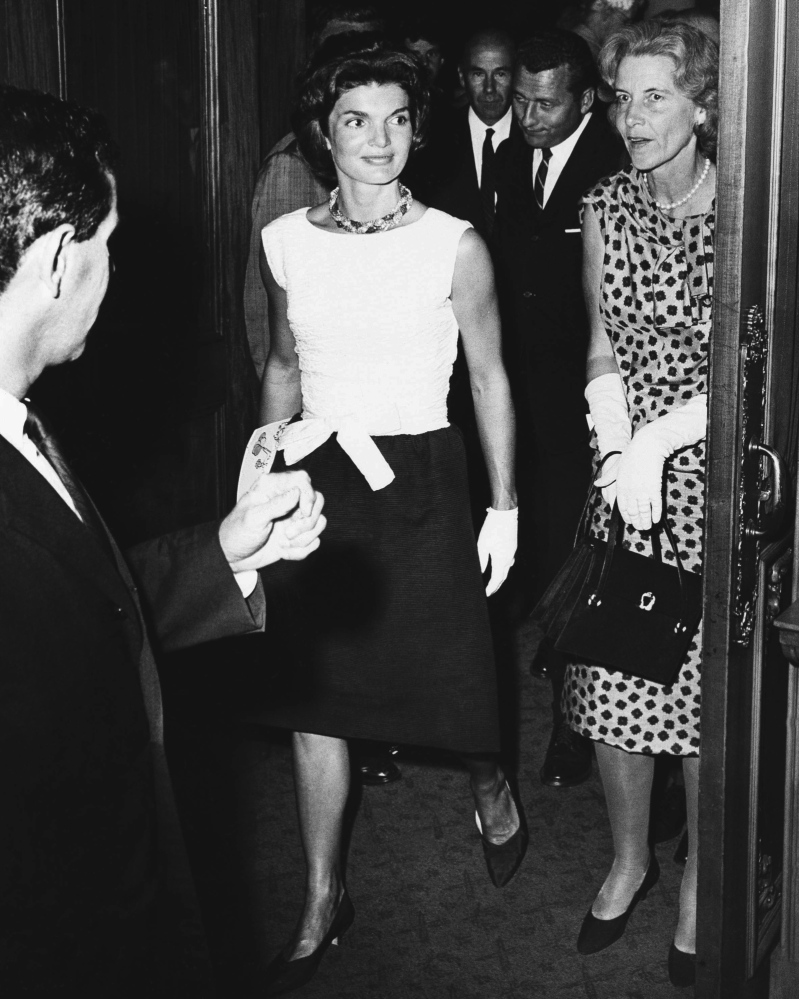Rachel “Bunny” Mellon, the Listerine fortune heiress who married arts patron and philanthropist Paul Mellon, was a confidante of Jacqueline Kennedy Onassis and redesigned the White House Rose Garden, died March 17 at her home in Upperville, Va. She was 103.
Tony Willis, her librarian and assistant, confirmed her death. The cause was not immediately available.
The Mellons donated more than 1,000 objects to the National Gallery of Art, including paintings by Cezanne, Degas and van Gogh. With Mellon’s sister and a family foundation, they also funded the construction of the gallery’s East Building in the 1970s, designed by architect I.M. Pei.
Despite her social connections and contributions to the cultural life of Washington, Mellon was publicity-averse and took great care to remain low-key. “Nothing should be noticed,” she told the New York Times in 1969. She was referring to the garden she had created at Oak Spring, her Fauquier County estate, where terraces, arbors and stonework formed a powerful and restrained design. But she might have been describing her own life.
“She was a marvelously shy person,” said architect Hugh Newell Jacobsen, a friend who worked with her on various projects at her many homes. “She hated the public light and having her picture taken, and Paul was very protective of that.”
At 101, she found herself improbably drawn into the legal battle of John Edwards, the former U.S. senator and presidential aspirant charged with violating campaign finance laws.
Edwards, a North Carolina Democrat, was tried in 2012 on charges that he took nearly $1 million in illegal campaign contributions from wealthy donors to support his mistress, Rielle Hunter, and conceal her from voters during his 2008 bid for the Democratic presidential nomination. Prosecutors attributed more than $700,000 to Mellon and $200,000 to Texas lawyer Fred Baron.
Mellon, who was not accused of breaking any laws, was entranced by the charismatic Edwards and wanted to help his quest for the presidency after he was criticized during the campaign for having a $400 haircut, according to witnesses in the case. Edwards dropped out of the race in January 2008.
On May 30, 2012, a federal jury in Greensboro, N.C., acquitted Edwards of one charge, and the judge declared a mistrial on the remaining five charges. The Justice Department later decided not to retry him on the five charges.
VICTIM OF A PONZI SCHEME
Late in life, Mellon also found herself ensnared in another legal case: In 2010, she was one of several victims of a $59 million Ponzi scheme created by New York investment adviser Kenneth Starr, who used $5.75 million of her money to buy an apartment.
The cases represented a departure for Mellon, who with her husband preferred to live a courtly life that navigated away from the shoals of ostentation, family scandal, legal controversy, media attention and celebrity. To the extent that she otherwise embraced the world of politics, it was as a friend to Jacqueline Kennedy, who turned to her in the 1950s as a young senator’s wife in need of friendship and guidance in Washington society.
Mellon had properties in Washington, New York, Cape Cod and Antigua in the West Indies, but she lived mostly on the couple’s 4,000-acre Fauquier County estate, where Paul Mellon ran his horse-breeding stable and she designed and cultivated gardens of supreme elegance. The estate, the size of Fairfax City, includes a landing strip for private aircraft. Paul Mellon died in 1999, at 91.
Mellon had a deep interest in interior design and architecture, and she became a hands-on patron of the designers she hired. But her primary interest was in gardening, landscape design and the history of gardens.
Jacobsen, the architect, recalled being bowled over by one of her design ideas. At Oak Spring, the path to the house was paved with sunken millstones interplanted with little blue flowers that matched perfectly the hue of the house mortar. “She was a brilliant designer with a terrific eye for color and form,” he said.
She also amassed a formidable collection of rare garden books, which was housed in a whitewashed stone library at Oak Spring designed by the Modernist architect Edward Larrabee Barnes. Her collection of antiquarian garden books, manuscripts and botanical prints was so extensive that she employed a librarian to care for them, and she commissioned scholars to write a series of volumes based on their rich horticultural content.
In the introduction to one volume, she wrote about how a children’s wildflower guide, given to her by her grandfather when she was 11, formed her love of gardening. “Our family house in Princeton, N.J., was surrounded by open fields that led me into the pleasure of discovery,” she wrote. “As a child, wild flowers were part of my feeling of freedom.”
LISTERINE AT HEART OF FORTUNE
Rachel Lowe Lambert was born in New York on Aug. 9, 1910, into a family that had made its fortune producing Listerine mouthwash. Her father, Gerard, was president of the Gillette Safety Razor Co. Her mother, also named Rachel, nicknamed her “Bunny,” which stuck. “I used not to like it,” she said once, “but now I am reconciled to it.”
In October 1929 – the month of the stock market crash that heralded the Great Depression– she was presented to society at a ball at her parents’ house. Three years later, she walked down the aisle with her first husband, Stacy B. Lloyd Jr., a businessman who became a noted horse breeder.
Like Paul Mellon, Lloyd was a Princeton University graduate and a foxhunter, and as Army officers, they roomed together in London during World War II. In 1946, Paul Mellon’s first wife, Mary, died at 41 of an asthma attack. In 1948, after the Lloyds divorced, Paul Mellon married Bunny.
Mellon’s survivors include a son from her first marriage, Stacy B. Lloyd III of Washington; two stepchildren, Timothy Mellon of Saratoga, Wyo., and Catherine Mellon Conover of Washington; five grandchildren; and two great-grandchildren. A daughter from her first marriage, Eliza Lloyd Moore, died in 2008.
STARTS COLLECTING ART
Paul Mellon’s father, banker and Treasury secretary Andrew W. Mellon, founded the National Gallery and funded the neoclassical West Building, which opened in 1941. When Paul and Bunny Mellon started collecting art in earnest, Mellon introduced her husband to 19th-century French painting, including the work of the impressionists and post-impressionists. He had been more interested in British art.
In 1955, the Mellons found, to their amazement, 70 wax sculptures by Degas in a New York gallery. After days of anxious deliberation, they bought the whole collection and displayed it at Oak Spring in a room they converted into an art gallery. Bunny Mellon designed the interior, which included green velvet wall panels to set off the sculptures.
In 1961, after reading about Thomas Jefferson’s gardening exploits, President John F. Kennedy asked her to redesign and improve the existing rose garden, which had been essentially untouched since 1913.
Working with the landscape architect Perry Wheeler, she designed the new West Garden, or Rose Garden, as a rectangular lawn framed by broad garden beds containing crab apple and magnolia trees, boxwood hedging, flower beds and rose bushes.
The garden became, as the president had wanted, the perfect setting for historic ceremonies and events. (Tricia Nixon, one of President Richard Nixon’s daughters, was married there in 1971.) Two days after the end of the 1962 Cuban Missile Crisis, Kennedy wrote Bunny Mellon a note to say the newly finished garden “has been our brightest spot in the somber surroundings of the last few days,” according to an account in Arthur Schlesinger Jr.’s book “A Thousand Days.”
After Kennedy’s assassination in 1963, Mellon carried out a redesign of the Rose Garden’s counterpart on the southeast side of the White House. At her insistence, the East Garden was dedicated to and named for Jacqueline Kennedy.
CHERISHED KENNEDY’S SCRAPBOOK
One of Mellon’s most cherished documents in her garden library was a scrapbook compiled by Jacqueline Kennedy tracing the history of both gardens. It included pressed flowers from the gardens.
“Jacqueline was an old and true and loyal friend of mine a long time before she went in the White House,” Mellon said in the 1969 Times interview. And they remained close long after Jacqueline Kennedy had left it.
When the former first lady, who by then was also the widow of shipping magnate Aristotle Onassis, wanted to build a house on Martha’s Vineyard in the early 1980s, Bunny Mellon introduced her to architect Jacobsen. The three collaborated on the project, which featured a series of interlocking saltboxes in a seaside garden. Mellon also designed the gardens of her own homes on Cape Cod and Antigua.
In her 90s, her husband and many of her friends, including Jackie Kennedy, had died. Her daughter, struck by a truck in New York, was in a coma for eight years before her death. In her loneliness, Mellon found John Edwards charming and handsome, and she recalled the aura of John Kennedy.
During Edwards’s trial, observers sought to explain why Mellon would funnel money to the politician while trying to hide the payments from her attorney, Alexander Forger. “She liked him as a person,” Forger said.
In his 2012 memoir, “Dropped Names,” actor Frank Langella, a longtime friend of Mellon’s, wrote candidly about the Edwards episode. “ ‘Well I suppose it’s my own damn fault,’ she told me, ‘he was so attractive. White shirt, white pants, sleeves rolled up. And you know I’m weak on good looks.’ ”
Langella added, “There is not much else Bunny Mellon is weak on; and her greatest strength, her most profound gift, is loyalty.”
Mellon once wrote that she had her first garden epiphany as a small child encountering a clump of garden phlox. “This towering forest of scent and white flowers was the beginning of ceaseless interest, passion and pleasure in gardens and books,” she wrote. “Like a magic carpet it has carried me through life’s experiences, discoveries, joys and sorrows. In sadness especially, it has been a hiding-place until my heart mended.”
Copy the Story LinkSend questions/comments to the editors.




Success. Please wait for the page to reload. If the page does not reload within 5 seconds, please refresh the page.
Enter your email and password to access comments.
Hi, to comment on stories you must . This profile is in addition to your subscription and website login.
Already have a commenting profile? .
Invalid username/password.
Please check your email to confirm and complete your registration.
Only subscribers are eligible to post comments. Please subscribe or login first for digital access. Here’s why.
Use the form below to reset your password. When you've submitted your account email, we will send an email with a reset code.